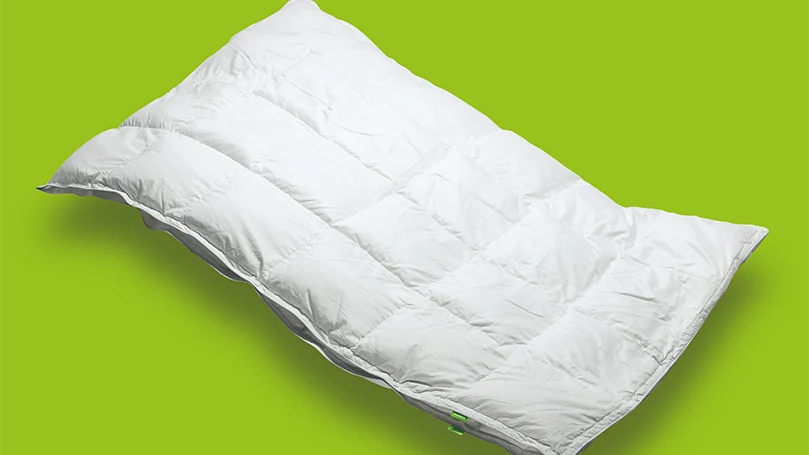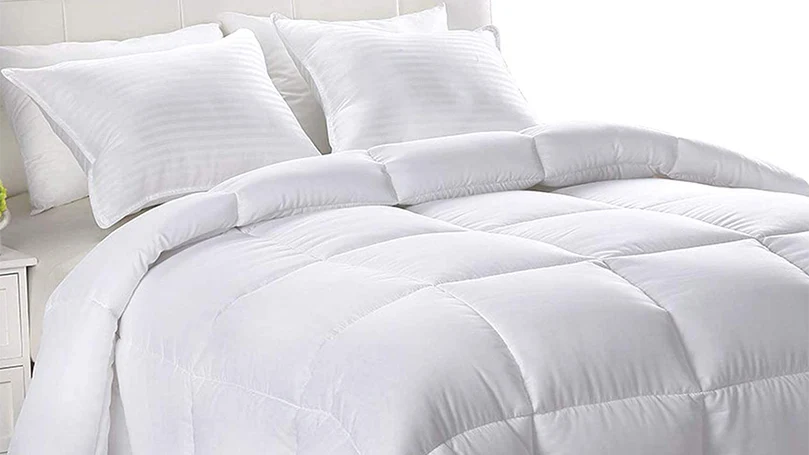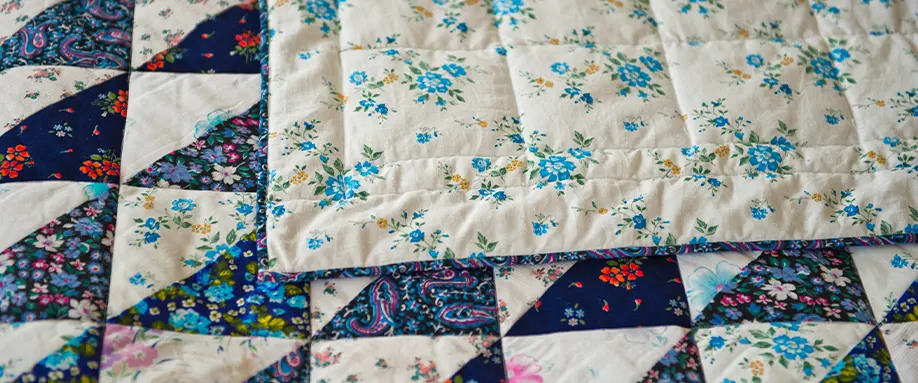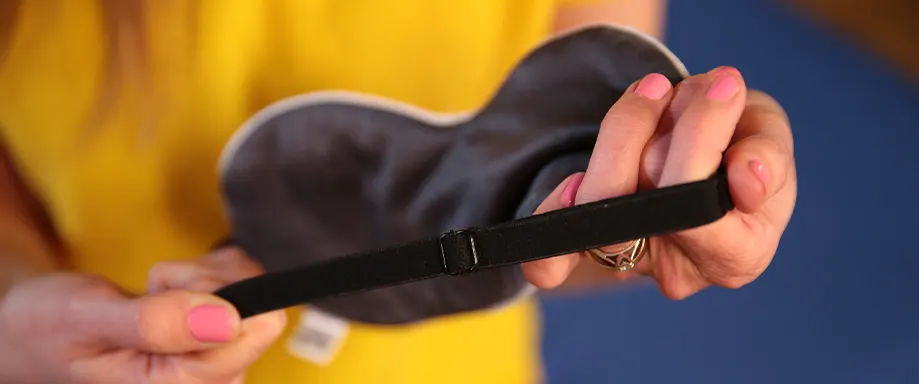How does a duvet differ from a comforter?
The main difference in a duvet vs comforter comparison lies in the fact that a comforter is a one-piece product and a duvet is a two-piece.
Comforters are usually, as opposed to a duvet, used right out the box. It is one-piece, quilted bedding that you don’t have to put in a cover. They are usually filled with fluffy synthetic fibres or cotton blends so that they can be easily washed and cleaned. Also, they're quilted, meaning that the filling is always evenly distributed throughout the entire comforter. In case it becomes less fluffy, make sure you “shake it” so the filling distributes evenly.

On the other hand, a duvet is meant to be used with a duvet cover, coverlet or a top quilt. It is essentially a glorified, fluffy, soft blanket filled with a variety of fillings such as feather and down, wool or synthetic fibres. They can be, but they're often not quilted, which often results in a less-polished look. Your duvet might have a cover is removable so you can wash it easily.
Furthermore, there are some minor differences in ease of maintenance, but more on that later. So, what is a duvet cover and why do we use a duvet cover?
What is a duvet cover, and why do we use it?
What’s a duvet cover? Well, think of a duvet cover as an oversized pillowcase – only you won’t use it to cover a pillow, but a duvet. A duvet cover is simply a fabric sheet (like a pillowcase for a pillow) that is meant to cover a duvet from all sides, unlike a coverlet, which we’ll discuss in a minute. In plain words – think of it as top sheet that you cover yourself up but this top sheet is the part of a duvet. Duvet cover protects your duvet and extends its lifespan.
Is a duvet cover removable?
A duvet cover is an easily removable part of a duvet, and it doesn’t have to come in the same package as a duvet. You can buy a duvet cover separately if you wish to have a more high-quality cover or simply a prettier, more decorative one.
A duvet cover can be made from various materials, including polyester, cotton or silk, and are always easily washable.
What is a duvet coverlet, and why do we use it?
A duvet coverlet is not a piece of bedding that you slide your duvet in – quite the contrary. A coverlet is simply a woven or a quilted top blanket that goes over the duvet. It is not attachable, nor will it cover the duvet from both sides.
More often than not, this is simply a decorative piece of bedding. Although you could theoretically snuggle under a coverlet, we don't really see the purpose of it.
All in all, a coverlet is nothing more than an aesthetically pleasing piece of fabric rather than a protective piece of layer as a duvet cover is.
How to wash a duvet?
On paper, a duvet is easier to clean than a comforter and here's why.
A duvet comes with a removable duvet cover, which is easily washable in any washing machine. Now, the duvet covers will be washed slightly differently based on the fabric they're made of, but that is something you will easily be able to read on the label of the cover. In any way, bear in mind that all duvet covers may have different cleaning instructions so make sure you read the instructions first.

Duvets are not machine washable
Duvets, on the other hand, usually aren't machine washable and can only be either professionally cleaned or taken for dry cleaning. Now, in case of some accidental spills or stains, you can rely on several DIY cleaning methods, and in case your duvet is machine washable, we have a full guide on how to do it over on our website.
Duvet/comforter sizes chart
Comforters come, as well as duvets, in similar sizes, although not the same ones. Furthermore, duvet and comforter sizes are also ranging from Single to Emperor. However, even though the names are similar, the dimensions are not.
Here are the exact sizes of the duvets and comforters.
Duvet and Comforter Size Chart
- Single – 135×200 cm
- Double – 200×200 cm
- King – 230×220 cm
- Super King – 260×220 cm
- Emperor – 290×235 cm.
The essential info and pros and cons of a duvet
Both duvets and comforters have their own advantages and disadvantages when compared in a duvet vs comforter battle. Duvets and comforters are both bedding options that may come in different variations and therefore can offer more or less cons, depending typically on the style and preferences of sleepers. In general, duvets have removable cover like a pillowcase has but also comes with a removable insert that you can take out.
A duvet filling
A duvet can be filled with a variety of materials/insert options. If you prefer natural fillings, you can go with wool or feather and down, and if you prefer synthetic fillings for hypoallergenic reasons, you may take that route. Your sleeping experience will be complete if you combine these with hypoallergenic pillows and therefore ensure that you are making your bed natural.
Cleaning of a duvet
Also, duvets are very easy to clean and hard to stain because they're used with duvet covers. All you need to do is to remove a cover, toss it into a washing machine, and that's it. A duvet, on the other hand, does not need to be washed often, but when it does, you can take it out for professional cleaning.
Also, they are usually better when it comes to keeping you warm during the winter, mostly due to various options when it comes to fillings.
On the other hand, they're rarely quilted, so when time goes by, the fillings can become clumped and bunched, resulting in an uneven duvet. While defining the difference between a duvet and comforter, let's define some of the pros and cons so you could understand whether you should go for a duvet or comforter.
PROS:
- A variety of different fillings are available on the market
- Easy to clean.
- Duvets can be warmer.
CONS:
- The filling can clump up over time.
- The duvet itself usually requires professional cleaning.
- It can cause allergies.
The essential info and pros and cons of a comforter
A comforter, or a quilt as the Brits like to call it, is a good choice for those that don't care about the “top sheet” cover and just want a piece of bedding to cover themselves with. A comforter is ready to be used as soon as you take it out of the bag. You won’t waste time sliding the cover over it or anything like that.

Filling of a comforter
Arguably, their biggest advantage is quilted fillings. The fillings of a comforter won't ever bunch up, as they're evenly distributed across the entire comforter, and unless you damage it –the comforter will stay good for a long time.On the other hand, a comforter can actually sleep hotter than the duvet. It will not keep you warmer, but it'll make you sweat more due to synthetic fillings.
Washing and cleaning a comforter
Also, even though most comforters are machine-washable, large comforters can rarely fit in a regular washing machine, and since you don’t usually use them with a cover – you will have to go out and clean it every time. We usually take them for dry clean. This is one of the biggest drawbacks of comforters.
PROS:
- Ready to use right away
- Evenly distributed quilted fillings
- Every comforter is highly durable.
CONS:
- A comforter might get hot
- They’re harder to clean
- It might not be warm enough for winter.
What is fill power?
Generally speaking, fill power is a way to measure the quality and the effectiveness of a down-filled duvet. Depending on the filling, it can be filled with down feathers or it can be filled with synthetic materials as well.
What does it mean “fluffy”?
Essentially, the term fluffy means airy. The fluffier the duvet is, the better it is at insulating, meaning you won't need any extra blankets to stay warm. The fluff comes from the air chambers, and those are essential when it comes to insulation. As a general rule of thumb when these are often sold, the higher fill power the duvet has, the lighter and more insulating it will be.
Is a duvet or a comforter the right choice for me?
So, how do you which one is the right choice for you? Well, unfortunately, we can't make the decision for you. However, we did provide you with all the necessary information about both of these products, so you can try and make your pick based on that. Duvets and comforters are similar, however, they also have different roles. It means that each of them serves the different purpose and therefore you should know your needs and priorities. Depending whether it's filled with down feathers or synthetic fibres, it might be more or less suitable for the winter/summer time.

Compare duvets and comforters and see which one works best for you – especially by understanding their main difference. If you sleep hot and you don't have a large washing machine – use a duvet. On the other hand, if you prefer keeping things simple and don't care for switching covers or going without a top sheet cover – go with the comforter and add some additional blankets if needed. It's easier to clean typically and it does not have an insert that you must remove and wash.
Duvet or comforter – the choice is yours!
Spread the word
FAQs on Duvet VS Comforter
While the duvet is better choice in terms of price, this is a matter of a personal preference. It depends on what you are looking for and what you need.
Technically speaking – YES! you should put a comforter in a duvet cover to extend the comforter's lifespan. However, a duvet comes with its removable cover in most of the cases.
Due to higher fill power, duvets are fluffier, especially if feature a quilted cover.
Because the duvet covers should accommodate the thickness of a duvet as well.
If it used daily, 3-5 times per year would be ideal.
Yes, you can put it into a washing machine and add soap/detergent and wash it on cycle with cold and warm water.















There are no comments yet
"*" indicates required fields